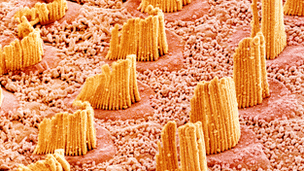Dr. Weeks’ Comment: In 1986 I completed research on the therapeutic aspect of sacred music wherein I described in detail the physiology of hearing and how high frequency tones (predominantly featured in ‘sacred” music) stimulate cerebral processes. In the process of describing the research, I was struck by a quotation attributed to Helen Keller – the famous deaf-mute who transcended these handicaps and attained heights most people never reach. Without hearing one is far more isolated that when deprived of sight.
Deaf gerbils ‘hear again’ after stem cell cure
By James Gallagher Health and science reporter, BBC News
Hearing partially improved when nerves in the ear, which pass sounds into the brain, were rebuilt in gerbils – a UK study in the journal Nature reports.
Getting the same improvement in people would be a shift from being unable to hear traffic to hearing a conversation.
However, treating humans is still a distant prospect.
If you want to listen to the radio or have a chat with a friend your ear has to convert sound waves in the air into electrical signals which the brain will understand.
This happens deep inside the inner ear where vibrations move tiny hairs and this movement creates an electrical signal.
However, in about one in 10 people with profound hearing loss, nerve cells which should pick up the signal are damaged. It is like dropping the baton after the first leg of a relay race.
The aim of researchers at the University of Sheffield was to replace those baton-dropping nerve cells, called spiral ganglion neurons, with new ones.

Analysis: A hairy problem
While there is excitement at the prospect of using stem cells to restore nerves in the ear this exact technique will not help the vast, vast majority of people with hearing loss.
Most hearing problems are caused by damage to the tiny delicate hairs which convert mechanical vibrations into electricity.
This research group have also converted embryonic stem cells into the early versions of the hair cells.
However, injecting them into the ear to restore hearing will be no easy task.
The hairs cells all need to be in the exact place and pointing in exactly the right direction.
Prof Dave Moore said using stem cells to repair the hairs was “almost an impossible task” and that the far-fetched concept of growing and transplanting a replacement ear seemed more likely.
They used stem cells from a human embryo, which are capable of becoming any other type of cell in the human body from nerve to skin, muscle to kidney.
A chemical soup was added to the stem cells that converted them into cells similar to the spiral ganglion neurons. These were then delicately injected into the inner ears of 18 deaf gerbils.
Over 10 weeks the gerbils’ hearing improved. On average 45% of their hearing range was restored by the end of the study.
Dr Marcelo Rivolta said: “It would mean going from being so deaf that you wouldn’t be able to hear a lorry or truck in the street to the point where you would be able to hear a conversation.
“It is not a complete cure, they will not be able to hear a whisper, but they would certainly be able to maintain a conversation in a room.”
About a third of the gerbils responded really well to treatment with some regaining up to 90% of their hearing, while just under a third barely responded at all.
Gerbils were used as they are able to hear a similar range of sounds to people, unlike mice which hear higher-pitched sounds.
The researchers detected the improvement in hearing by measuring brainwaves. The gerbils were also tested for only 10 weeks. If this became a treatment in humans then the effect would need to be shown over a much longer term.
There are also questions around the safety and ethics of stem cell treatments which would need to be addressed.
‘Tremendously encouraging’Prof Dave Moore, the director of the Medical Research Council’s Institute of Hearing Research in Nottingham, told the BBC: “It is a big moment, it really is a major development.”
However, he cautioned that there will still be difficulties repeating the feat in people.
“The biggest issue is actually getting into the part of the inner ear where they’ll do some good. It’s extremely tiny and very difficult to get to and that will be a really formidable undertaking,” he said.
Dr Ralph Holme, head of biomedical research for the charity Action on Hearing Loss, said: “The research is tremendously encouraging and gives us real hope that it will be possible to fix the actual cause of some types of hearing loss in the future.
“For the millions of people for whom hearing loss is eroding their quality of life, this can’t come soon enough.”

